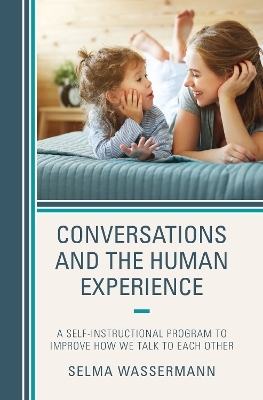
Conversations and the Human Experience
Rowman & Littlefield (Verlag)
978-1-4758-6753-4 (ISBN)
The main thesis of this book is that words have power. They have power to nourish – to add substantially to the way people feel about themselves. They also have power to hurt – to diminish another’s feelings about self. The words we use to each other can bring us closer together or drive us further apart.
The materials in the book provide readers with opportunities to examine and reflect on the relationship between human interactions and the development of positive human relationships, specifically how conversations work to enable positive relationships or diminish them.
These include being able to “tune in” to what the other person is saying, freeing oneself from the need to judge, being respectful, and having a clear and non-defensive idea of what is coming out of one’s mouth.
The materials in the book also provide a self-instructional program to develop one’s skills in using human interactions that build more positive relationships.
Selma Wassermann is a Professor Emerita in the Faculty of Education at Simon Fraser University, and a recipient of the University Award in Teaching Excellence. Her teaching expertise includes the development of teaching for thinking and interpersonal skills.
Preface
Acknowledgements
Introduction
What’s the good of it? (It’s not about the cheese)
How the book is organized
Part One: The Essential Components of Effective Human Interactions
Chapter 1: Listening: “tuning in”
Key conditions in active listening
Developing active listening skills
Chapter 2: Responding
The overarching condition of respect
Selecting appropriate responses
Paraphrasing
End notes
One final word
Chapter 3: The art of the question
Questions that should be avoided
More productive questions
Turning questions into statements of inquiry
The well-orchestrated discussion
Conclusion
Chapter 4: Once more with feeling
Conclusion
Chapter 5: Caveats: When the divide is too great
Part Two
Chapter 6: Introduction to the skill development materials
Chapter 7: Introduction to facilitative interactions: Task 1
Studying the conversations
Thinking about conversations #1
Thinking about conversation #2
Thinking about conversation #3
Thinking about conversation #4
Reflecting on interpersonal facilitative responding
Conclusion
Figure 1: Analyzing Responses in Human Discourse
Chapter 8: Practice in choosing appropriate responses
Practice task
Self-evaluation of your responses
Conclusion
Chapter 9: Practice in attending and responding with respect (encore)
Task
Self-evaluation of your responses
Conclusion
Chapter 10: Creating your own scenario
Self-evaluation of your conversation
Conclusion
Chapter 11: One-on one practice in attending and responding with respect (A)
Pre-conditions
Task
Conclusion
Chapter 12: One-on-one practice in attending and responding with respect (B)
Points to remember in interpersonal discussions
Pre-conditions
Task
Conclusion
Chapter 13: Practice in attending and responding (Encore)
Conclusion
Chapter 14: Using effective interpersonal skills in real situations
Chapter 15: Last Words
Just one more thing
Bibliography
| Erscheinungsdatum | 22.07.2022 |
|---|---|
| Verlagsort | Lanham, MD |
| Sprache | englisch |
| Maße | 148 x 217 mm |
| Gewicht | 308 g |
| Themenwelt | Sachbuch/Ratgeber |
| Geisteswissenschaften ► Psychologie ► Pädagogische Psychologie | |
| Sozialwissenschaften ► Pädagogik | |
| ISBN-10 | 1-4758-6753-0 / 1475867530 |
| ISBN-13 | 978-1-4758-6753-4 / 9781475867534 |
| Zustand | Neuware |
| Informationen gemäß Produktsicherheitsverordnung (GPSR) | |
| Haben Sie eine Frage zum Produkt? |
aus dem Bereich


